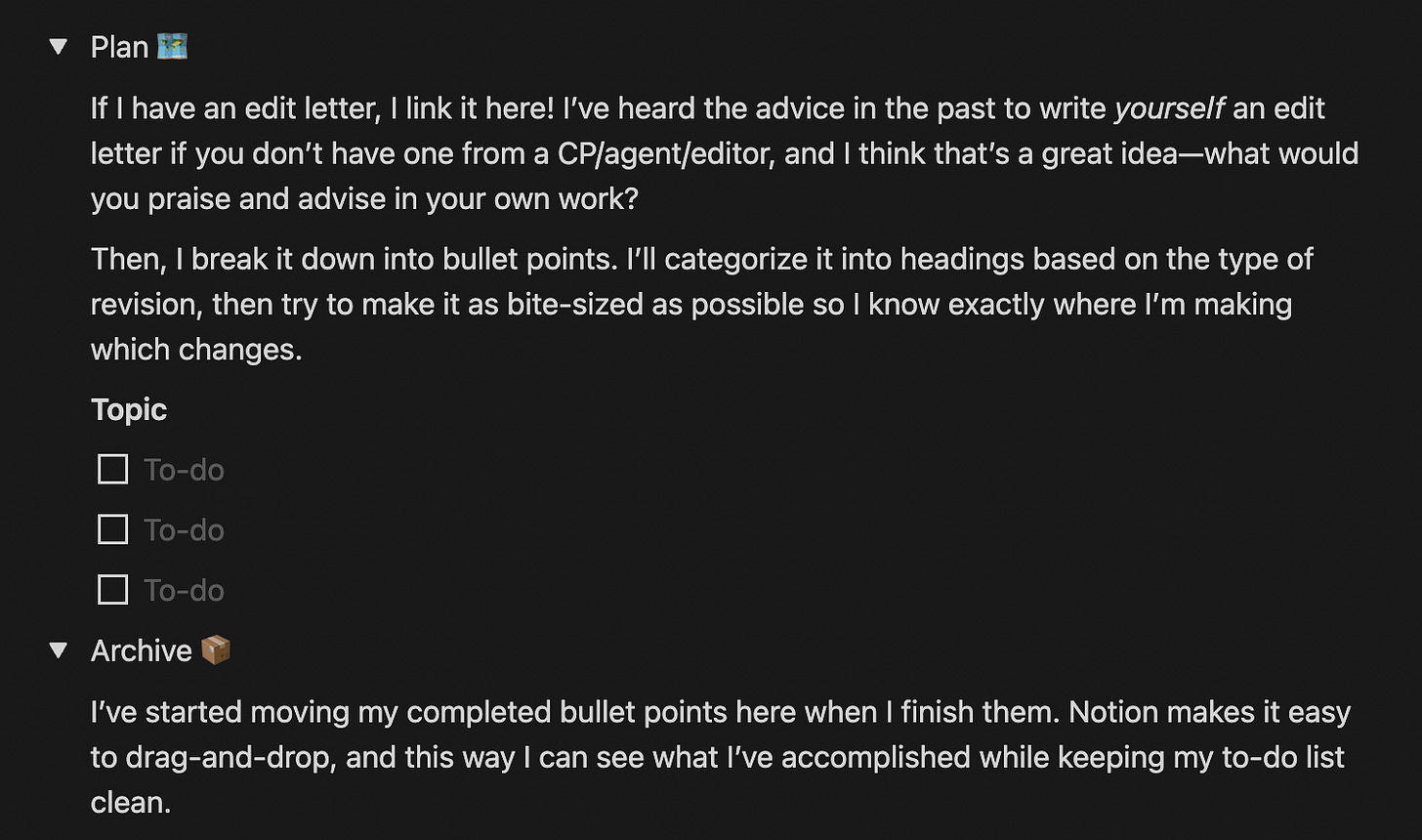reviewing revision
navigating uncharted territory with some reminders-to-self (and a Notion template)
I turned in a revision last week, and I’ve also been discussing revision with my students, the creative and analytical writers alike.
The process has inspired a lot of reflection. Because what a strange process revision is, right? When I teach high school writers to revise, I always start by breaking the word down: re-vision. To re-see.
Part of me is always a little terrified at the start of a revision. When I hold a mirror up to my own drafting process, what will I be ashamed to discover? What oddities made it into my work that I’m not even aware of, where are my ideas murky or lazy? (I didn’t realize how much I used the word blanch until a CP pointed it out in one of my first novels. I now have a strict one-blanch-per-book rule.)
But mirrors are magical, too. Looking-glass portals where sometimes we forget we were the ones who wrote these words in the first place and—in the very best moments—fall into the story we wrote because we wanted to read it.
So, with all of this in mind, I thought today I’d offer the very practical with the more philosophical: the Notion template I use for revision, since enough of you found the last one useful that I figured I’d share again (here it is, if you’d like to duplicate it!); and the underpinning principles that get me through the uncharted wilds of revision.
Grab a coffee, pull up a chair, and let’s chat.
Decrease the stakes.
Revision can be terrifying—making the jump from what we’ve already created to the next vision in our head can feel like leaping to the top of a ladder with no rungs. So much of my work in revision is about lowering the jumps so I can move through the process with less fear and more ease.
That’s where the Notion template comes in, I guess! A few things I’ll highlight:
the plan: I’ll categorize it into headings based on the type of revision, then try to make it as bite-sized as possible so I know exactly where I’m making which changes. (I wish I could share a screenshot of what this list looked like in my latest round, but the project is still secret, so… maybe soon? Let me know if that would be useful to see!)
the archive: the place I move completed items from the checklist. I used to delete them, but even that felt too definitive—what if I didn’t complete it as well as I thought? If it’s in the archive, I can always pull it back out to re-evaluate or fine-tune.
the playground: When I’m adding something new during revision, sometimes I like to play around with it in a new place first—to keep it low stakes and make it feel like drafting, even when I’m inserting it into a more polished draft.
the graveyard: Here lie the bones of those scenes I had to cut. ☠️ It’s just so much easier to part with them when I know they still exist somewhere!
“You don’t eradicate bad habits. You just become more aware of them.”
I said this to a student recently, and only when the words left my mouth did I realize just how true they were.
With every book, I add new personal tics to my revision checklist; I suspect a lot of us need to comb our work for similar habits, but I bet you have some that I don’t have to worry about as much, and vice versa! (Would love to hear, if you’re willing to share.)
My own bad habits/things I always want to double-check:
Dialogue: I read it aloud to be sure it feels as natural as possible. I also do a pass to be sure each character sounds distinct—does their vocabulary, cadence, slang, etc. all feel so characteristic it could distinguish them from any other character?
Dialogue tags: Sometimes unique dialogue tags sneak their way into my work, and I remind myself to pare back to a simple “said” or “asked” whenever possible. Ditto for adverbs—where can the dialogue communicate its own tone? And do I need a tag at all, or can I replace it with an action or description?
Setting: My early drafts suffer from white room syndrome, and I always need to add more setting details as I flesh them out. I make sure every scene has been set with multiple sensory details and try to stretch beyond visuals (what does it smell like?!).
~Fancy~ punctuation: A wise CP once advised me to keep special punctuation marks (em-dashes, semi-colons, colons, ellipses…) to one per page, since they really stand out; sometimes I break this rule, but it’s a good guideline to ensure I’ve done my best to streamline every sentence. Magical though the em-dash is, sometimes it’s accordioned a sentence that needn’t be.
Filter words: I live and die by Jeni Chappelle’s list of filter words—the reminders that we’re reading through a character’s eyes. I try to remove any superfluous ones to ensure the reader is as close to the narrator’s experience as possible.
Repetitive thoughts: Sometimes I don’t trust the reader enough in a first draft and need to remind myself to pare back on any moment when I’m over-explaining something that could be easily understood from the surrounding context.
First lines: Is there any “throat-clearing” I can cut when I was getting warmed up? Am I starting in the most immediate, appropriate moment possible?
Last lines: are they as hooky as possible? Do they make the reader want to keep turning the page into the next chapter? Or, if that doesn’t feel tonally fitting, do they leave the reader on a fermata that makes the final mood linger?
I line-edited a page of my current manuscript with my students (excruciating; it’s a good thing I’m used to being mortified in front of teens on a daily basis) and reminded them that, yes, this exercise is a great chance to judge their teacher, but also for them to reflect on what their own lists will look like. The more we revise, the more we know what our work needs—and the more comfortable we are with letting it be a little messy before it takes a more polished shape.
Feel for the truth line by line.
I always work from big-picture changes to small details; after all, what use is fine-tuning the setting in a scene you’re going to cut or rewrite from scratch? It reminds me of how sculptors supposedly work from marble: seeing the vision inside the stone, chiseling out large chunks first, and then smaller ones.
George Saunders writes in his Story Club newsletter (required reading; go subscribe right now if you’re not already) about the importance of moving line by line to see if a story feels right:
The way I revise is: I read my own text and imagine a little meter in my head, with “P” on one side (“Positive”) and “N” on the other (“Negative”). The game is to read the story the way I would read someone else’s – noting my honest, in-the-moment reactions – and then edit accordingly.
This involves making thousands of what I’ve come to think of as “micro-decisions.” These are instantaneous, intuitive – I just prefer this to that. It’s something like trying to hit a baseball – you wait (you read), you react – not conceptualizing, not thinking about, you know, the Intended Bat Velocity, or any of that – I just have a feeling and react to that feeling, in the form of a cut phrase, or an added word, or an urge to move this whole section, and so on.
And then I do that over and over, for months, sometimes years, until that needle stays up in the “P” zone for the whole length of the text.
It’s a beautiful approach, simple yet profound. How else do we know whether we’ve written what we want?
I even found myself doing this on a recent newsletter, reworking a transition between ideas about four different times until it landed just right. I could tell something was off, that there was something more honest I wanted to say.
This is always my last stage of reviewing a manuscript—reading it front to back, start to finish, to be sure it all rings true.
Use the process to become more aware of your strengths, not just your weaknesses.
I have a horrible habit of deleting all the nice comments from my feedback as soon as I read them, leaving myself only an actionable list of things to change—my CPs are shaking their heads at me right now, since they’ve struggled to train me out of this habit (and now are probably simply resigned to it).
I still like my actionable list, but I’m increasingly learning that revision can be just as valuable for pointing out the places where my voice shines so I can capitalize on those strengths. I’ve started treasuring these moments as a reminder of what I’m trying to do with a piece. This collection of praise can become a touchstone for me when I begin a revision, when I get stuck, when I need a boost of motivation.
A few things I’m trying to hold on to as strengths thanks to recent friends’ comments (🙏):
establishing backstory with economical, vivid details
pining, especially from my male LI 😌
distinct character voices & parallel wounds
atmosphere/~vibes~
the kissing scenes 😇
Even writing that out was incredibly painful, which is probably a sign that it’s important to practice reflecting on the positives! But Saunders’s meter above also includes “P” for Positive, and I think honing in on the things we love about our work helps us tackle the things that aren’t clicking yet in order to bring them up to the same level, no?
I recently read a passage in Finding Water (a recent Julia Cameron discovery of mine) that reminded me of this same idea:
“In America, we are taught how to take things apart, not how to build them. In our school system we learn how to criticize, not construct. As a result, people know how to weigh in with what is wrong but without balancing it with comments about what is right.”
Don’t forget to balance your self-criticism with comments about what is right. (Primarily a note to self, as always…)

Other friends have written some really great pieces on how they approach revision—some of them more pragmatic and actionable than this one—but I hope anything here is a reminder of the power of taking it step by step, being present, and using revision to help us continue to grow on what will hopefully be long, fruitful writing journeys.
In that vein… If you have other revision principles or tips that help you tackle these wilds, I’m always trying to learn and would love to hear your wisdom!
Much love always,
🤍 Emily








so much wisdom and great advice in this post! (i'm in the thick of a revision and still so overwhelmed by it somehow so i ate this one up lol!) i'd love to hear more about how you break things down into bite-sized pieces!
how did i miss this one?! chock full of great nuggets to keep in mind as i step away from my draft and prep for my own revision.